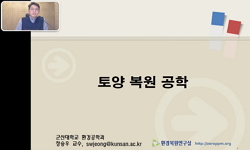지하 심부 토양 및 퇴적물 내 토착 미생물의 활성화에 따른 중금속 거동을 이해하기 위하여, 독성 중금속으로 오염된 국내 일부 지역의 시료를 대상으로 혐기적 환경에서 유산염(lactate)을 탄...
http://chineseinput.net/에서 pinyin(병음)방식으로 중국어를 변환할 수 있습니다.
변환된 중국어를 복사하여 사용하시면 됩니다.
- 中文 을 입력하시려면 zhongwen을 입력하시고 space를누르시면됩니다.
- 北京 을 입력하시려면 beijing을 입력하시고 space를 누르시면 됩니다.


국내 일부 오염 토양 및 퇴적물 내 토착 미생물에 의한 중금속의 지구화학적 거동 연구 = Study on Geochemical Behavior of Heavy Metals by Indigenous Bacteria in Contaminated Soil and Sediment
한글로보기https://www.riss.kr/link?id=A100573533
-
저자
송대성 (전남대학교) ; 이종운 (전남대학교) ; 고일원 (광주과학기술원) ; 김경웅 (광주과학기술원) ; Song, Dae-Sung ; Lee, Jong-Un ; Ko, Il-Won ; Kim, Kyoung-Woong
- 발행기관
- 학술지명
- 권호사항
-
발행연도
2007
-
작성언어
Korean
- 주제어
-
등재정보
KCI등재,SCOPUS,ESCI
-
자료형태
학술저널
- 발행기관 URL
-
수록면
575-585(11쪽)
-
KCI 피인용횟수
8
- 제공처
-
0
상세조회 -
0
다운로드
부가정보
국문 초록 (Abstract)
지하 심부 토양 및 퇴적물 내 토착 미생물의 활성화에 따른 중금속 거동을 이해하기 위하여, 독성 중금속으로 오염된 국내 일부 지역의 시료를 대상으로 혐기적 환경에서 유산염(lactate)을 탄소원으로 투입한 후 약 25일간에 걸친 비소 및 중금속(카드뮴, 구리, 납, 아연) 함량 변화를 관찰하였다. 실험 결과, 미생물이 투입된 시료의 경우 미생물이 투입되지 않은 비교시료에 비하여 용존 카드뮴, 납, 아연이 효과적으로 제거되었으며, 이는 토착 황산염 환원(sulfate-reducing) 박테리아의 활성화로 인해 생성된 환원상태의 황이 이들 중금속과 황화물을 형성하며 침전시켰기 때문으로 여겨진다. 비소의 경우, 미생물을 투입한 시료 중 황산염의 함량이 높은 덕음 토양에서는 제거율이 높은 반면 황산염의 함량이 상대적으로 낮은 화북 토양, 동두천 퇴적물에서는 지속적으로 그 함량이 증가하였다. 적절한 탄소원 및 황산염을 투입해 독성 중금속으로 오염된 지질 매체 내의 토착 미생물을 활성화시킨다면 이들 중금속의 원위치(in situ) 고정화를 통한 이동도 감소의 효과를 볼 수 있을 것으로 여겨지나, 비소로 동시에 오염된 경우 발생할 수 있는 비소 용출 가능성에 대한 고려가 필요하다.
다국어 초록 (Multilingual Abstract)
Microbial control of the geochemical behavior of heavy metals (Cd, Cu, Pb, and Zn) and As in contaminated subsurface soil and sediment was investigated through activation of indigenous bacteria with lactate under anaerobic condition for 25 days. The r...
Microbial control of the geochemical behavior of heavy metals (Cd, Cu, Pb, and Zn) and As in contaminated subsurface soil and sediment was investigated through activation of indigenous bacteria with lactate under anaerobic condition for 25 days. The results indicated that dissolved Cd, Pb and Zn were microbially removed from solutions, which was likely due to the formation of metal sulfides after reduction of sulfate by indigenous sulfate-reducing bacteria. Soils from the Dukeum mine containing a large amount of sulfate resulted in complete removal of dissolved As after 25 days by microbial activities, while there were gradual increases in dissolved As concentration in soils from the Hwabuk mine and sediments from the Dongducheon industrial area which showed low $SO_4{^2-}$ concentrations. Addition of appropriate carbon sources and sulfate to contaminated geological media may lead to activation of indigenous bacteria and thus in situ stabilization of the heavy metals; however, potential of As release into solution after the amendment should be preferentially investigated.
참고문헌 (Reference)
1 Stookey, "a new spectrophotometric reagent for iron. Anal. Chem." 42 : 779-781, 1970
2 "The effects of different carbon sources on microbial mediation of arsenic in arsenic-contaminated sediment" 27 : 159-168, 2005
3 Oremland, R.S, "The ecology of arsenic" 300 : 939-944, 2003
4 Tebo, B.M, "Sulfate-reducing bacterium grows with Cr(VI), U(VI), Mn(IV), and Fe(III) as electron acceptors" 162 : 193-198, 1998
5 "Study on geomicrobiological reductive precipitation of uranium and its long-term stabilization" 43 : 331-338, 2006
6 "Stabilization of available arsenic in highly contaminated mine tailings using iron" 37 : 189-195, 2003
7 "Speciation of submicrogram per liter levels of arsenic in water; On-site species separation integrated with sample collection" 4 : 2342-2347, 2000
8 Macy, "Selenate reduction by a Pseudomonas species a new mode of anaerobic respiration. FEMS Microbiol. Lett." 61 : 1989p.195-198.
9 Kim, J.Y, "Removal of As(III) in contaminated groundwater using iron and manganese oxide-coated materials" 38 : 571-577, 2005
10 Sani, R.K, "Reduction of uranium(VI) under sulfatereducing conditions in the presence of Fe(III)-(hydr)oxides" 68 : 2639-2648, 2004
1 Stookey, "a new spectrophotometric reagent for iron. Anal. Chem." 42 : 779-781, 1970
2 "The effects of different carbon sources on microbial mediation of arsenic in arsenic-contaminated sediment" 27 : 159-168, 2005
3 Oremland, R.S, "The ecology of arsenic" 300 : 939-944, 2003
4 Tebo, B.M, "Sulfate-reducing bacterium grows with Cr(VI), U(VI), Mn(IV), and Fe(III) as electron acceptors" 162 : 193-198, 1998
5 "Study on geomicrobiological reductive precipitation of uranium and its long-term stabilization" 43 : 331-338, 2006
6 "Stabilization of available arsenic in highly contaminated mine tailings using iron" 37 : 189-195, 2003
7 "Speciation of submicrogram per liter levels of arsenic in water; On-site species separation integrated with sample collection" 4 : 2342-2347, 2000
8 Macy, "Selenate reduction by a Pseudomonas species a new mode of anaerobic respiration. FEMS Microbiol. Lett." 61 : 1989p.195-198.
9 Kim, J.Y, "Removal of As(III) in contaminated groundwater using iron and manganese oxide-coated materials" 38 : 571-577, 2005
10 Sani, R.K, "Reduction of uranium(VI) under sulfatereducing conditions in the presence of Fe(III)-(hydr)oxides" 68 : 2639-2648, 2004
11 Jones, C.A, "Rates of microbially mediatied arsenate reduction and solubilization" 64 : 600-608, 2000
12 Torsvik, V, "Prokaryotic diversity - magnitude, dynamics, and controllong factors" 296 : 1064-1066, 2002
13 Society of America, Washington, D.C, "Precipitation of arsenic trisulfide by Desulfotomaculum auripigmentum" 63 : 2022-2028, 1997
14 Nealson, K.H, "Microorganisms and biogeochemical cycles: what can we learn from layered microbial communities?" Mineralogical 5-34, 1997
15 "Microbial reduction of uranium. Nature" 350 : 413-416, 1991
16 Park, J.M, "Microbial effects on geochemical behavior of arsenic in As-contaminated sediments" 88 : 134-138, 2006
17 "Metals and Their Compounds in the Environment" 945-958, 1991
18 Grandlic, C.J, "Lead pollution in a large, prairie-pothole lake (Rush Lake, WI, USA): Effects on abundance and community structure of indigenous sediment bacteria" 144 : 119-126, 2006
19 US DOE, "Internet ref." US DOE 2007
20 "Interactions of bacteria and environmental metals, finegrained mineral development and bioremediation strategies" John Wiley and Sons, Chichester, England 227-261, 2002
21 "In situ visualization of high genetic diversity in a natural microbial community" 178 : 3496-3500, 1996
22 Uhrie, J.L, "In situ immobilisation of heavy metals associated with uranium leach mines by bacterial sulphate reduction" 43 : 231-239, 1996
23 Alloway, "Heavy Metals in Soils. Blackie and Son." 1990
24 "Geomicrobiological effects on arsenic behavior in anaerobic sediment from abandoned gold mine area" 43 : 448-457, 2006
25 Bowen, "Environmental Chemistry of the Elements. Academic Press" 333-, 1979
26 Liu, Y,G, "Effects of solids concentration on removal of heavy metals from mine tailings via bioleaching" 141 : 202-208, 2007
27 "Effect of indigenous bacterial activity on arsenic mobilization under anaerobic conditions" 31 : 221-226, 2005
28 Seidel, H, "Bioremediation process for sediments contaminated by heavy metals: Feasibility study on a pilot scale" 38 : 1582-1588, 2004
29 "Biological reduction of uranium in groundwater and subsurface soil" 250 : 21-35, 2000
30 Herbel, M, "Biogeochemical processes controlling the speciation and transport of arsenic within iron coated sands" 228 : 16-32, 2006
31 Lee, J.-U, "Bacterial effects on geochemical behavior of elements : An overview on recent geomicrobiological issues" 33 : 353-365, 2000
32 Nickson, R, "Arsenic poisoning of Bangladesh groundwater" 395 : 338-, 1998
33 Lee, J.-U, "Arsenic adsorption onto Pseudomonas aeruginosa cell surface" 38 : 525-534, 2005
34 M, "A comparative study of various biosorbents for removal of chromium ions from industrial wastewater. Process Biochem." 29 (29): 1 5-, 1994
동일학술지(권/호) 다른 논문
-
남한의 중생대 광화유체의 기원과 진화특성: 광상 성인과의 관계
- 대한자원환경지질학회
- 최선규
- 2007
- KCI등재,SCOPUS,ESCI
-
태백산 광화대 북부에서 칼린형 금광화작용 부존 잠재력 평가를 위한 지구화학 탐사
- 대한자원환경지질학회
- 성규열
- 2007
- KCI등재,SCOPUS,ESCI
-
토양라이시미터를 이용한 토양오염확산.거동 예측을 위한 토양공극수 채취와 분석
- 대한자원환경지질학회
- 고일원
- 2007
- KCI등재,SCOPUS,ESCI
-
토양내 중금속 실시간 탐지를 위한 레이저 유도붕괴 분광법의 활용에 대한 소개
- 대한자원환경지질학회
- 고은정
- 2007
- KCI등재,SCOPUS,ESCI
분석정보
인용정보 인용지수 설명보기
학술지 이력
| 연월일 | 이력구분 | 이력상세 | 등재구분 |
|---|---|---|---|
| 2023 | 평가예정 | 해외DB학술지평가 신청대상 (해외등재 학술지 평가) | |
| 2020-01-01 | 평가 | 등재학술지 유지 (해외등재 학술지 평가) |  |
| 2013-01-01 | 평가 | 등재 1차 FAIL (등재유지) |  |
| 2010-01-01 | 평가 | 등재학술지 유지 (등재유지) |  |
| 2008-01-01 | 평가 | 등재학술지 유지 (등재유지) |  |
| 2006-01-01 | 평가 | 등재학술지 유지 (등재유지) |  |
| 2004-01-01 | 평가 | 등재학술지 유지 (등재유지) |  |
| 2001-07-01 | 평가 | 등재학술지 선정 (등재후보2차) |  |
| 1999-01-01 | 평가 | 등재후보학술지 선정 (신규평가) |  |
학술지 인용정보
| 기준연도 | WOS-KCI 통합IF(2년) | KCIF(2년) | KCIF(3년) |
|---|---|---|---|
| 2016 | 0.35 | 0.35 | 0.34 |
| KCIF(4년) | KCIF(5년) | 중심성지수(3년) | 즉시성지수 |
| 0.29 | 0.27 | 0.625 | 0.19 |




 ScienceON
ScienceON 스콜라
스콜라






